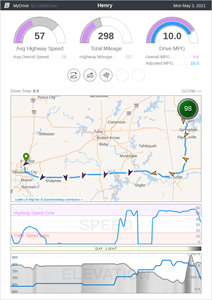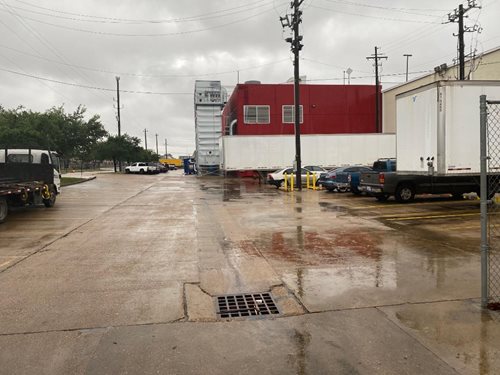
"Where will I be dispatched to next?"
I was asked by a carrier to drive for them as a company driver in order to see what kind of fuel economy could be achieved with their trucks. In this endeavor, I am driving their regular routes just as their drivers would. There are no special considerations being taken from the company's dispatch office for the duration of this test. The trucks I am driving are late model Freightliner Cascadias powered by Detroit DD15, 455 HP/1650 FPT backed up by a Detroit DT12 direct drive automated manual transmission with a final rear axle drive ratio of 2.41. The wheelbase on these particular trucks is 230” which does not lead to having an optimal trailer gap. The longer wheelbase is necessitated for the extra clearance required for a spare tire rack which is mounted behind the sleeper.
So far I have taken three trips on three different routes in three different trucks and have recorded fuel mileages of 8.4, 7.2, 7.0, 8.7, 10.0, and 10.0. I have been keeping track of the fuel mileage using Pedal Coach which I have found to be very accurate in comparison to the figures recorded calculating at the fuel pump. There has been rain, wind, heavy loads, light loads, traffic jams, and everything else that you would encounter in a normal day's operation. Some of the trailers had side skirts while some had mismatched dual tires.
This particular carrier has their max cruise speed set at 70 mph. This puts their RPMs at about 1450. The DD15 is much happier in regards to fuel mileage if you keep the RPMs below 1400. In reality, the DD15 is extremely fuel-efficient in the 1150 to 1250 RPM range. But staying under 1400 RPMs seems to really help. On my second and third run of this project, I limited my cruise speed to 67 MPH which seemed to yield much more favorable fuel mileage results. As you can see from the Pedal Coach results in this post.
The carrier's drivers have also been riding along to observe the methods I employ to increase fuel efficiency. On the first day of running at the lower 67 mile-per-hour cruise speed, another truck from the same carrier passed us on 3 different occasions during our dispatched route. The next day when we were nearly unloaded, the truck that had passed us those 3 times arrived to deliver at the same receiver as us. As it turns out, both of us were dispatched on the same exact route. The truck which was running 70 MPH cruise speed evidently had a hard time keeping their driver-side door closed. To those who don't know what it means to have a problem keeping the driver's side door closed, it is in reference to a driver who runs really fast, stops, then runs really fast again to make up for the time lost during their unscheduled stops. One of the keys to fuel efficiency that most successful owner-operators employ is carefully scheduled rest stops. And as they put it: keeping the driver's side door closed and maintaining a steady methodical pace. It's the classic story we all grew up learning of the “Hare and the Tortoise.” The hare would run like a jackrabbit and the slow but steady tortoise wins the race in the end.
I'd like to address the subject that the title of this blog is based on... In the Dark. During my career in the trucking industry, which started out in 1983, I had never really driven for a trucking company other than my own. The first two places I drove for at the beginning of my career were both private carriers. Driving for a private carrier is much different than driving for a truck company as you are transporting goods and commodities produced or distributed by the company you are driving for. In each of those cases, I planned, dispatched, and routed my own deliveries. Working with a trucking company and dealing with a dispatcher, as I am doing this week, is quite different since I have to wait to hear from them about what my next move will be. Working with a dispatcher allows me to know what the plan is only a short distance into my week.
As an independent owner-operator, I am accustomed to knowing and having a plan for the whole week and most times planning into my next week. There are a lot of advantages to planning, which include fueling, resting, and many other factors that affect the outcome of your week, month, and year. I compare it a lot to how a good driver is able to scan the road beyond a short distance in front of them. It seems that the best way to compare the difference would be when driving in dense fog you are not able to see far enough down the highway to travel at a timely pace.
In closing, I'd like to say it's been a pleasure and an honor that this carrier chose me to do this project with them along with now having an interesting perspective into a company driver's life.
Screenshots Courtesy of Pedal Coach
These were not state-of-the-art ringer fuel mileage spec'd trucks. They were standard fare, bread and butter, everyday specs, and still recorded fuel mileage that would have been considered outstanding in a not-so-distant past.
4/26 Laredo to Temple 8.4 mpg
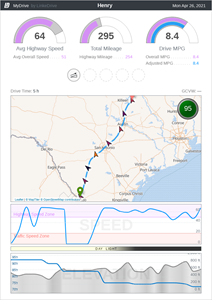
4/27 Temple to Austin 7.2 mpg
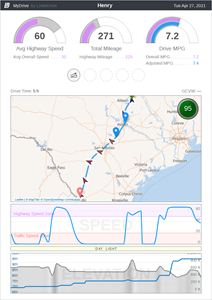
4/29 Laredo to Houston 7.0 mpg
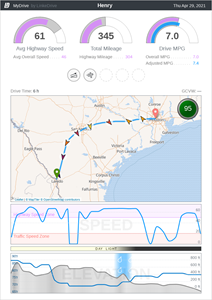
4/30 Houston to New Braunfels 8.7 mpg
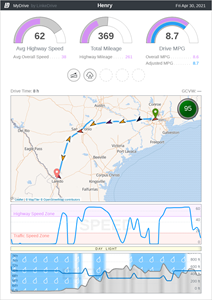
5/2 Laredo, Tx to Edmonton, OK 10.00 mpg
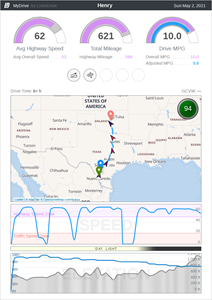
5/3 Edmonton, OK to Bentonville, AR 10.00 mpg
